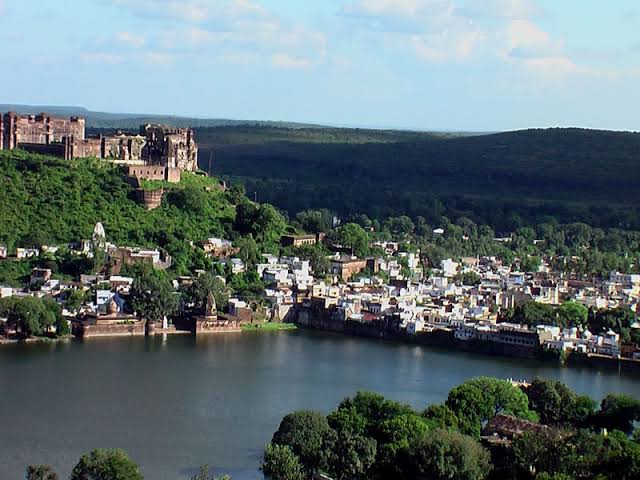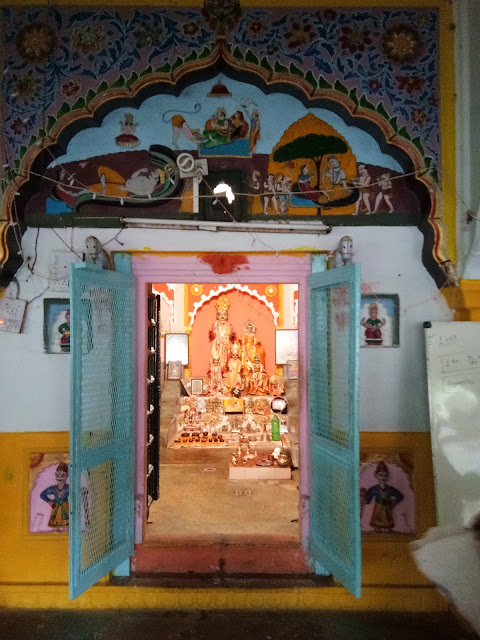𝗪𝗵𝗼 𝘄𝗮𝘀 𝗨𝗱𝗮𝘆𝗯𝗵𝗮𝗻 𝗥𝗮𝘁𝗵𝗼𝗿𝗲 𝗥𝗲𝗮𝗹𝗹𝘆?
𝗪𝗵𝘆 𝗮 𝗴𝗿𝗲𝗮𝘁 𝘄𝗮𝗿𝗿𝗶𝗼𝗿 𝘀𝗵𝗼𝘄𝗻 𝗶𝗻 𝗯𝗮𝗱𝗹𝗶𝗴𝗵𝘁?
𝗔𝗻 𝗮𝗻𝗮𝗹𝘆𝘀𝗶𝘀 𝗼𝗳 𝘁𝗵𝗲 𝗺𝘆𝘁𝗵 𝗺𝗮𝗸𝗶𝗻𝗴 𝗶𝗻 𝗠𝗮𝗿𝗮𝘁𝗵𝗮 𝗵𝗶𝘀𝘁𝗼𝗿𝘆.
Raja udaibhan Rathore of bhinay was great grandson of great Rao chandrasen Rathore and He was also a relatives of Mewar's Maharana Raj Singh, Their character has been shown very wrong in the movie where (एक धर्म निष्ठ राजा उदयभान राठोड़ को एक विधवा स्त्री का अपहरण करने वाला दिखाया गया)
The reality of history of Udaybhan Rathore and Tanaji
Udaybhan rathore was the head of Bhinai thikana (84 villages) in Ajmer. He was the direct descendant of the famous Rao Chandrasen, Raja of Marwar (4th generation) who resisted Akbar all his life and never made any alliance with mughals like Maharana Pratap. Later in 1783, Maharaja of Jodhpur gave title of Raja to Bhinai family for their military service. Bhinai family and their direct descendant Raja Sh Mayuraj Singh still lives in Ajmer. Anyway coming to Udaybhan Rathore and story of Tanaji. Jai Singh's march on Shivaji and treaty of Purandar (1665) is a well known episode to repeat here. After getting the hill forts from Shivaji under the treaty, Jai Singh didn't have enough man-power to man every one of the small forts because of his next campaign against Bijapur. Jai Singh personally took over a couple of important forts like Kondhana (Sinhgarh), Purandar etc. Others were given to some mughals or their fortification walls destroyed. Jai Singh died in 1667 near Burhanpur while enroute to the north.
The fort of Kondhana was under Udaybhan Rathore placed by Jai Singh not sent specially by Aurangzeb as shown in the movie. In 1670 the fort was captured by marathas after a sanguinary fight in which the maratha army leader Tanaji Malusare and Udaybhan Rathore both died. The reality was simple, marathas under Tanaji captured the fort from Udaybhan Rathore but as we will see, slowly this story expanded to one of the biggest fiction in maratha history. Start with contemporary evidence, there is not a single contemporary evidence of this. First mention of this fight is in Sabhasad bakhar written almost 30 years after the battle. The Sinhgadh campaign is given in detail, that there was one Tanaji malusure who commanded the army. Although this battle is described in detail, there was no exaggeration about Udaybhan which were made later. Udaybhan was only mentioned as a great warrior who was the commander of the Kondhana fort. And that Tanaji climbed the fort with help of mawle soldiers who were expert in mountain climbing.
Even Chitnis Bakhar which was written about 130 years later doesn't say anything wrong about Udaybhan. The event is also mentioned vividly by British historian Grant Duff's in his 'History of Mahrathas' written in 1826, story is same as Sabhasad bakhar. Nothing wrong against Udaybhan here too. Later in British period this story is deformed to another level. In 19th century one powada was composed allegedly by one Tulsidas shahir. The powadas are ballads; songs sung by wandering performers, there is nothing historical about it. In this powada Udaybhan is made a monster, some description about Udaybhan is as follows, Udaybhan eats one cow, one goat and more than a maund of rice in ONE MEAL. He has 18 wives and 12 sons (which is also fake as he had only one son and which wasnt in kondhana)
He remains drunk and doesnt go to fight until all his fake 12 sons get killed. Cherry on the top, it is shown that he also converted to Islam, goes to mosque and when he died he cried "Allah". In the ballad there are many other unbelievable things like how a ghorpad (monitor lizard) helps Tanaji to climb up the fort which was not true according to Sabhasad Bakhar, and like how ghorpad stopped climbing midway and then Tanaji asked her to climb but when she doesnt, Tanaji threatens her that he will cook her and will eat her if she doesnt climb. Then the ghorpad again starts climbing. HG Rawlinson who wrote 'shivaji the maratha' added an english translation of the powada, he himself say that there is no contemporary evidence of this story.
There are many other geographical mistakes too like how Rajgarh is confused with Raigarh by the composer. Although the story has little historic value, the story being interesting was copied by some colonial and pune writers. Later comes a man named Hari Narayan Apte, a historical novel writer who is hailed as Walter Scott of Marathi literature. He wrote in 1903 a novel named Gad aala pan sinh gela. He btw also wrote a novel named "Tiger of Mysore" on Tipu Sultan. He went a step further from Powadas and added in this an extra story of Kamal Kumari. And also made Udaybhan rathore an illegitimate son of Mewar Rana from a slave girl. And how did illegitimate son of a sisodia rajput adopted Rathore surname is a mystery that Apte didn't think over.
Anyway in his story Udaybhan kidnapped Kamal Kumari, a Rajput widow against her wishes, she wanted to become Sati. Udaybhan is shown in much disgust in this book. Finally a man of honour Tanaji frees Kamal Kumari from Udaybhan's clutches so she can commit sati. This book of Apte gained quite popularity and became anchor point for further writings on Udaybhan and Tanaji. Many works on this were composed later, to name a few Acharya Chatursen a hindi novel writer's book "Sayadri ki Chattane" follows the same story of Udaybhan. There were marathi films made on this story before independence. And finally a hindi film Tanhaji in 2020 by a Marathi film maker Om Raut. This film is on another level, it takes all the story from these fictions but remove all those impossibles like eating cows and all to make story believable and also specifically mentions that Udaybhan is Rajput which was removed by censor board. He shows Aurangzeb as a simple guy weaving caps but made Udaybhan a vilest guy you could imagine, there was also a scene of Udaybhan killing his own mother because she was "neecha khoon", all this was removed by censor board not by film maker but by censor board. This is how character of Udaybhan was ridiculed beyond any imagination by slow process of fictional myth making.
The truth is much simpler, that Udaybhan was a mere soldier and was appointed by Jai Singh and was doing his duty. For siding with mughals, even Shivaji attacked many forts while serving under mughals. Shivaji's son Shambhaji also served under mughals. Shivaji's father Shahji also served under Mughals, Bijapur and Ahmadnagar Sultans as it suited him. But looks like Udaybhan got in the wrong side of Maratha myth-making. Finally I expect atleast descendants of Udaybhan in Bhinai and Badanwara would raise some awareness on this.
For people asking in DM abt dialogues in the movie, read the 1st change in the list of changes made by censor board. This is at 1hr 26 min in the movie where Kamal's brother tell the story of Kamal and Udaybhan's past to captured Tanaji.
We wanted to do a thread on this myself, didn't reach the trigger point to carry on with it though. Thanks, @Engr_Who for saving our effort 😅.
Historiography of the whole thing as traced by G.S. Sardesai comes from 'Ballads of the Marathas' by H.A. Ackworth, who also did the vernacular version with a certain Shankar Tukaram Shaligram in the 1890s.
Ackworth helped by some locals compiled the local stories in his work.
The Malusare story comes from 'Tanaji Malusare Yane Sinhghad Ghetla'/'The Ballad of Tanaji Maloosre', a ballad that is taken from the local lower-caste Koli community that sought and did see Sanskritisation and Upward Mobility in the Maratha ecosystem towards the late 1800s. The sole purpose of the Powada is to claim the Kolis as Kshatriyas, an assertion the powada tries to make again and again. This mythmaking attempts to compare and elevate the Kolis to communities Kolis locally percieved as of a relatively higher birth be it Maratha or Mughal. There is a multititude of supernatural impossibilities in the Powada - Goddesses materialising, spirits flying, lizards and elephants talking, bodies possessed, astral projections, dead resurrected, all of which when combined reach triple digits, so we will skip those here.
Udaybhan Rathore along with his sons is called a Mughal and at the same time a Kshatriya skilled in 5 weapons. These discrepancies were observed by H.A. Ackworth himself who brought forth the Powada first time in writing. The movie 'Tanaji' however doesn't derive from the Powada directly but from the Marathi Novelist Harinarayan Apte's 'Gad Ala Pan Simha Gela', that further embellishes upon the Powada.
The work has been called by authors as one that deals in "exaggerations" and "impossibilities".
Ackworth himself wasn't too sure about the authorship of Tulsidas as cited by the Powada who apparently didn't even write in Marathi but Braj. A supporting argument for this would be that Shivaji endorsed poets of the Braj Langauge like Bhooshan.
This explains the overreaching and repetitive themes of a Maratha Lower-Caste Koli Hindu Vs Northern Upper-Caste Rajput Imperialist in the Powada.
The battle was otherwise insignificant as Marathas couldn't hold the fort for more than 8 months. This further solidifies the point. While Maratha histories during the time of Phule and Shahu of Kolhapur were directed against local Brahmins of Pune, as the Imperial National establishment set in, their movement was infiltrated by those very Marathi Brahmins like Tilak, they turned vehemently anti-Rajput.
Marathi narratives directed against Rajputs are from a time when most of North India was under them, directly as Princely states or indirectly through Zamindaris. As the idea of nation changed for Marathis, the pretension of 'ownership' also changed, now it included whole India. It is unfortunate, how unreliable histories like these were weaponized as propaganda and used to target a community that has been at the forefront of protecting this part of the world for millennia so that people of a certain region can turn the North into a political colony.








































